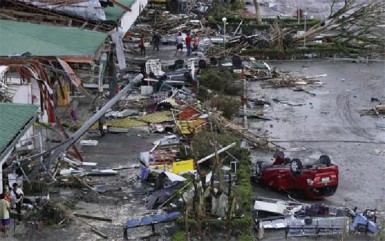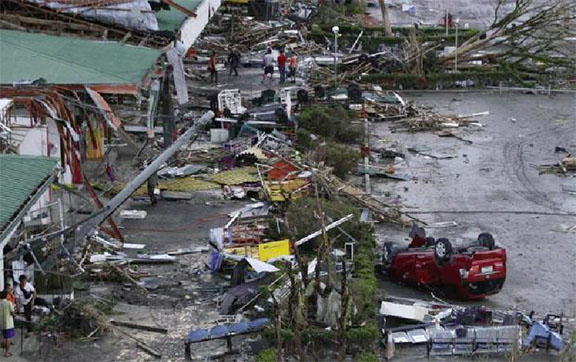TACLOBAN, Philippines (Reuters) – At least 10,000 people died in the central Philippine province of Leyte after Typhoon Hai-yan, one of the strongest storms ever to make landfall, lashed the province, swallowing coastal towns, a senior police official said today.

About 70 to 80 per cent of the area in the path of Haiyan in Leyte province was destroyed, said Chief Superintendent Elmer Soria.
“We had a meeting last night with the governor and the other officials. The governor said based on their estimate, 10,000 died,” Soria told Reuters.
A day after Typhoon Haiyan churned through the Philippine archipelago in a straight line from east to west, rescue teams struggled to reach far-flung regions, hampered by washed out roads, many choked with debris and fallen trees.
The death toll is expected to rise sharply from the fast-moving storm, whose circumference eclipsed the whole country and which late on Saturday was heading for Vietnam.
Among the hardest hit was coastal Tacloban in central Leyte province, where preliminary estimates suggest more than 1,000 people were killed, said Gwendolyn Pang, secretary general of the Philippine Red Cross, as water surges rushed through the city.
“An estimated more than 1,000 bodies were seen floating in Tacloban as reported by our Red Cross teams,” she told Reuters. “In Samar, about 200 deaths. Validation is ongoing.”
She expected a more exact number to emerge after a more precise counting of bodies on the ground in those regions.
Witnesses said bodies covered in plastic were lying on the streets. Television footage shows cars piled atop each other.
“The last time I saw something of this scale was in the aftermath of the Indian Ocean Tsunami,” said Sebastian Rhodes Stampa, head of the UN Disaster Assessment Coordination Team sent to Tacloban, referring to the 2004 earthquake and tsunami.
“This is destruction on a massive scale. There are cars thrown like tumbleweed and the streets are strewn with debris.”
The category 5 “super typhoon” weakened to a category 4 on Saturday, though forecasters said it could strengthen again over the South China Sea en route to Vietnam.
Authorities in 15 provinces in Vietnam have started to call back boats and prepare for possible landslides. Nearly 300,000 people were moved to safer areas in two provinces alone – Da Nang and Quang Nam – according to the government’s website.
The Philippines has yet to restore communications with officials in Tacloban, a city of about 220,000. A government official estimated at least 100 were killed and more than 100 wounded, but conceded the toll would likely rise sharply.
The national disaster agency has yet to confirm the toll but broken power poles, trees, bent tin roofs and splintered houses littered the streets of the city about 580 km (360 miles) southeast of Manila.
The airport was nearly destroyed as raging seawaters swept through the city, shattering the glass of the airport tower, leveling the terminal and overturning nearby vehicles.
“Almost all houses were destroyed, many are totally damaged. Only a few are left standing,” said Major Rey Balido, a spokesman for the national disaster agency.
Local television network ABS-CBN showed images of looting in one of the city’s biggest malls, with residents carting away everything from appliances to suitcases and grocery items.
Airport manager Efren Nagrama, 47, said water levels rose up to four meters (13 ft) in the airport.

